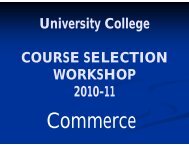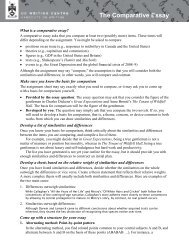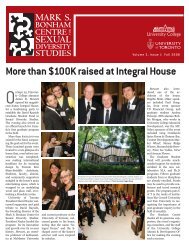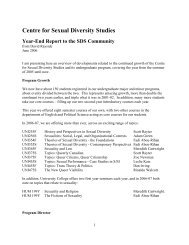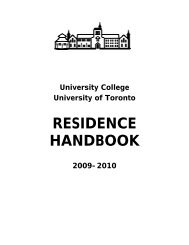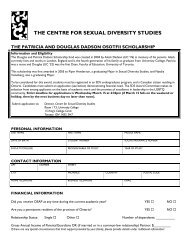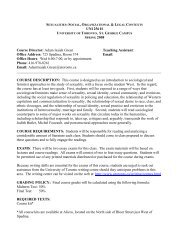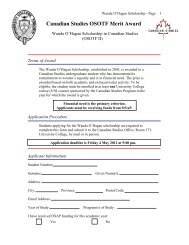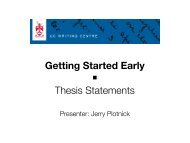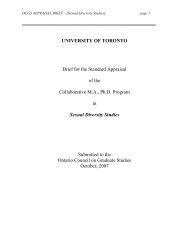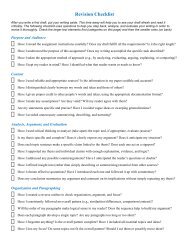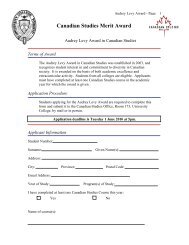Special Topics in Health Studies - University College - University of ...
Special Topics in Health Studies - University College - University of ...
Special Topics in Health Studies - University College - University of ...
Create successful ePaper yourself
Turn your PDF publications into a flip-book with our unique Google optimized e-Paper software.
<strong>University</strong> <strong>College</strong><br />
<strong>Health</strong> <strong>Studies</strong> Program<br />
UNI309: <strong>Special</strong> <strong>Topics</strong> <strong>in</strong> <strong>Health</strong> <strong>Studies</strong> (Fall 2012)<br />
Instructor: Laura R. Moll, PhD., MSW, RSW<br />
Email: laura.moll@utoronto.ca<br />
Classes: September 14, 2012 – December 5, 2012<br />
Fridays- 10-12<br />
Room: UC153<br />
Office Hours: Fridays, 12-1, Rm. TBD or by appo<strong>in</strong>tment<br />
Course Description<br />
The purpose <strong>of</strong> this course is to provide students with an overview <strong>of</strong> ag<strong>in</strong>g with and <strong>in</strong>to a<br />
disability. Students will have the opportunity to develop an awareness and understand<strong>in</strong>g <strong>of</strong> the<br />
health system and issues associated with population ag<strong>in</strong>g (ag<strong>in</strong>g and disability) and what it<br />
means to live with and grow older with a pre-exist<strong>in</strong>g disability. The theoretical lens and<br />
assumptions associated with disability will be identified and described <strong>in</strong> or order to demonstrate<br />
how they are used to <strong>in</strong>form health care and rehabilitation policies and practices <strong>in</strong>tended to<br />
improve the everyday lives <strong>of</strong> these <strong>in</strong>dividuals.<br />
Objectives:<br />
By the end <strong>of</strong> the course, students will:<br />
1. Develop and understand<strong>in</strong>g <strong>of</strong> the issues that <strong>in</strong>dividuals ag<strong>in</strong>g with and <strong>in</strong>to disability are<br />
confronted with across the life course.<br />
2. Become familiar with the concepts and theories that <strong>in</strong>form quantitative and qualitative<br />
studies on ag<strong>in</strong>g with and <strong>in</strong>to disability<br />
3. Learn how health care concepts and theories guide health care policies and practices <strong>in</strong>tended<br />
to support the quality <strong>of</strong> life, physical and social-psychological well-be<strong>in</strong>g <strong>of</strong> <strong>in</strong>dividuals<br />
with childhood conditions and elderly <strong>in</strong>dividuals with disability.<br />
4. Ga<strong>in</strong> the strategies and resources to critically appraise peer-reviewed studies<br />
5. Advance their knowledge, understand<strong>in</strong>g and experience <strong>in</strong> writ<strong>in</strong>g a scholarly research<br />
paper<br />
They will be able to dist<strong>in</strong>guish between ag<strong>in</strong>g with and <strong>in</strong>to disability<br />
UNI309: <strong>Special</strong> <strong>Topics</strong> <strong>in</strong> <strong>Health</strong> <strong>Studies</strong> Page 1
Assignments:<br />
Assignment #1: Research Outl<strong>in</strong>e and Annotated Bibliography (40%)<br />
The purpose <strong>of</strong> this assignment is for students to select an issue associated with either ag<strong>in</strong>g with<br />
or <strong>in</strong>to disability. The outl<strong>in</strong>e should <strong>in</strong>clude the follow<strong>in</strong>g sections:<br />
Problem Identification- describe the issues and concerns that are confronted by a group <strong>of</strong><br />
<strong>in</strong>dividuals, In your description it is important to develop an argument why there is a need for<br />
engag<strong>in</strong>g <strong>in</strong> research on this area <strong>of</strong> <strong>in</strong>terest. Consider what gap it may fill <strong>in</strong> association with<br />
our current knowledge and the research that exists to date. Describe the costs associated with the<br />
topic under <strong>in</strong>vestigation. Specifically, consider the short and long-term impact that these issues<br />
have on the <strong>in</strong>dividual, his/her family, and their social environment.<br />
Introduction and Background- this section should describe the scope <strong>of</strong> the problem, <strong>in</strong>clud<strong>in</strong>g<br />
demographic attributes and what we k now based on the current research available (literature<br />
review).<br />
Annotated bibliography (should <strong>in</strong>clude both quantitative and qualitative research)<br />
http://www.writ<strong>in</strong>g.utoronto.ca/advice/specific-types-<strong>of</strong>-writ<strong>in</strong>g/annotated-bibliography<br />
Guidel<strong>in</strong>es are available at the above l<strong>in</strong>k. Feel free to contact me if you have further questions<br />
This assignment should be 10-12 pages (double spaced)<br />
Grade: 40% <strong>of</strong> total Grade<br />
Assignment #2: Research Paper<br />
The components <strong>of</strong> this assignment will be provided <strong>in</strong> class.<br />
Grade: 50% <strong>of</strong> total Grade<br />
Due Date: November 30, 2012<br />
Note students will be provided with a list <strong>of</strong> topics they may be <strong>in</strong>terested <strong>in</strong> research<strong>in</strong>g.<br />
Participation: (10% <strong>of</strong> total grade)<br />
In or to achieve an <strong>in</strong>-depth understand<strong>in</strong>g <strong>of</strong> health issues associated with ag<strong>in</strong>g, they are<br />
expected to attend every class, do the course read<strong>in</strong>gs, and participate <strong>in</strong> class and group<br />
discussions<br />
UNI309: <strong>Special</strong> <strong>Topics</strong> <strong>in</strong> <strong>Health</strong> <strong>Studies</strong> Page 2
Overview <strong>of</strong> Classes<br />
DATES TOPIC READINGS<br />
September 14, 2012 Introduction Naidoo Vishaya., Putnam<br />
September 21, 2012 Theoretical Foundations <strong>of</strong><br />
Ag<strong>in</strong>g and Disability<br />
Overview <strong>of</strong> first Assignment<br />
September 28, 2012 Concepts and theories that is<br />
associated with Disability<br />
October 5, 2012 Do<strong>in</strong>g Research on Ag<strong>in</strong>g and<br />
<strong>Health</strong><br />
October 12, 2012 The Life Course Perspective and<br />
Ag<strong>in</strong>g<br />
October 19, 2012 Factors Impact<strong>in</strong>g the <strong>Health</strong> and<br />
well-be<strong>in</strong>g <strong>of</strong> Ag<strong>in</strong>g with and<br />
<strong>in</strong>to Disability<br />
First Assignment is due<br />
October 26, 2012 Caregiver Life Course: Key<br />
Issues: Implications for <strong>Health</strong><br />
Care Policies<br />
November 2, 2012 Costs associated with<br />
Caregiv<strong>in</strong>g: Implications for<br />
Caregivers and Recipients <strong>of</strong><br />
Care<br />
November 4, 2012 Last day to drop Fall courses<br />
November 9, 2012 Self-directed fund<strong>in</strong>g versus<br />
Formal Care Programs<br />
Michelle., et al. (2011)<br />
McPherson Barry D. (1998),<br />
Chapter 1 and 3<br />
Bickenbach JE., Chatterji S., et<br />
al. (1999), Oliver, M. (1998).,<br />
Morris, J. (2001)<br />
TBD<br />
Giele, J. Z. and G. H. Elder Jr.<br />
(1998)., Chapter 1; O'Rand, A.<br />
M. (1998)<br />
TBD<br />
Hebert RS. And Schulz R.<br />
(2006), Seltzer MM., Greenberg<br />
JS., et al. (2001), L<strong>in</strong>dgren, C.<br />
(1993)<br />
Fast, J., J. Eales, et al. (2001),<br />
Kuyper, M. and F. Wester (1998)<br />
Benjam<strong>in</strong> AE. (2001)<br />
November 16, 2012 W<strong>in</strong>ter Break (No Classes) Office Hours (Optional)<br />
November 23, 2012 Significant life Transitions:<br />
<strong>Health</strong> Care Access and<br />
Utilization<br />
November 30, 2012 Bridg<strong>in</strong>g the Gap between health<br />
care services and programs for<br />
people ag<strong>in</strong>g with and <strong>in</strong>to<br />
disability: Policy Implications<br />
F<strong>in</strong>al research paper is due<br />
Campbell ML., Sheets D., et al.<br />
(1999)<br />
Priestley, M. and P. Rabiee<br />
(2002), Priestley M. (2000).<br />
UNI309: <strong>Special</strong> <strong>Topics</strong> <strong>in</strong> <strong>Health</strong> <strong>Studies</strong> Page 3
Course Schedule & Read<strong>in</strong>gs:<br />
September 14, 2012<br />
Introduction to Ag<strong>in</strong>g with and <strong>in</strong>to Disability<br />
In this session, the course outl<strong>in</strong>e. Students will be provided with an <strong>in</strong>troduction to population<br />
ag<strong>in</strong>g with a focus on demographic attributes. Dist<strong>in</strong>ctions between ag<strong>in</strong>g with and <strong>in</strong>to<br />
disability will be highlighted. We will end with exam<strong>in</strong><strong>in</strong>g the issues at stake for both groups.<br />
Required Read<strong>in</strong>gs:<br />
Naidoo, Vishaya, Putnam, Michelle, Klassen, Thomas, and Sp<strong>in</strong>del, Andria. (2011) Bridg<strong>in</strong>g the<br />
Gaps: Support<strong>in</strong>g People Ag<strong>in</strong>g <strong>in</strong>to and with Disability<br />
Supplementary Read<strong>in</strong>gs:<br />
Gilson, S. F. and F. E. Nett<strong>in</strong>g (1997). "When People with Pre-Exist<strong>in</strong>g Disabilities Age <strong>in</strong><br />
Place: Implications for Social Work Practice." <strong>Health</strong> and Social Work 22(4): 290-297.<br />
Tighe, C. A. (2001). "Work<strong>in</strong>g at Disability: A Qualitative Study <strong>of</strong> the Mean<strong>in</strong>g <strong>of</strong> <strong>Health</strong> and<br />
Disability for Women with Physical Impairments." Disability and Society 16(4): 511-529.<br />
Tremblay, M., J. Tryssenaar, et al. (1997). "Ag<strong>in</strong>g with a pre-exist<strong>in</strong>g disability: Develop<strong>in</strong>g a<br />
bibliography and curriculum guide for health and social science educators." Educational<br />
Gerontology 23(6): 567-579.<br />
September 21, 2012<br />
Theoretical Foundations <strong>of</strong> Ag<strong>in</strong>g and Disability<br />
In this session students will learn about ag<strong>in</strong>g as a social process and the theories associated with<br />
them. The research process associated with the study <strong>of</strong> ag<strong>in</strong>g and health, and ag<strong>in</strong>g with<br />
disability will be highlighted.<br />
Students will have an opportunity to discuss their topic <strong>of</strong> <strong>in</strong>terest and be provided with an<br />
overview <strong>of</strong> assignment #1.<br />
Required Read<strong>in</strong>gs:<br />
McPherson Barry D. (1998). Chapter #1: Ag<strong>in</strong>g as a Social Process. In, Ag<strong>in</strong>g as a Social<br />
Process: Introduction to Individual and Population Ag<strong>in</strong>g, (p.3-30).<br />
McPherson Barry D. (1998). Chapter #3: Study<strong>in</strong>g Ag<strong>in</strong>g Processes: Theory and Research. In,<br />
Ag<strong>in</strong>g as a Social Process: Introduction to Individual and Population Ag<strong>in</strong>g, (p.53-94).<br />
September 28, 2012<br />
Concepts and theories that is associated with Disability<br />
In this session students will be <strong>in</strong>troduced to the ma<strong>in</strong> concepts and theories associated with<br />
research on disability and health. Some <strong>of</strong> the follow<strong>in</strong>g questions should be considered:<br />
1. How does the way we conceptualize ag<strong>in</strong>g and disability impact the way health studies are<br />
designed?<br />
UNI309: <strong>Special</strong> <strong>Topics</strong> <strong>in</strong> <strong>Health</strong> <strong>Studies</strong> Page 4
2. What are the strengths and limitations <strong>of</strong> do<strong>in</strong>g research on a topic that is <strong>in</strong>formed by these<br />
concepts?<br />
3. What <strong>in</strong>formation is missed or ga<strong>in</strong>ed<br />
Required Read<strong>in</strong>gs:<br />
Bickenbach, J. E., Chatterji, S., Badley, E. M., & Ustun, T. B. (1999). Models <strong>of</strong> disablement,<br />
universalism and the <strong>in</strong>ternational classification <strong>of</strong> impairments, disabilities and handicaps.<br />
Social Science and Medic<strong>in</strong>e, 48, 1173-87.<br />
Oliver, M. (1998). "Theories <strong>of</strong> disability <strong>in</strong> health practice and research." British Medical<br />
Journal 317(7170): 1446-1449.<br />
Morris, J. (2001). "Impairment and Disability: Construct<strong>in</strong>g an Ethics <strong>of</strong> Care that Promotes<br />
Human Rights." Hypatia 16(4): 1-16.<br />
October 5, 2012<br />
Do<strong>in</strong>g research on ag<strong>in</strong>g and health<br />
Students will learn to identify the issues we need to consider when do<strong>in</strong>g research on ag<strong>in</strong>g and<br />
health. They will beg<strong>in</strong> to th<strong>in</strong>k about a research topic and beg<strong>in</strong> to develop an outl<strong>in</strong>e for their<br />
research paper. The components that comprise a research abstract and research paper will be<br />
highlighted.<br />
Group Work: critical appraisal <strong>of</strong> studies on ag<strong>in</strong>g and health.<br />
October 12, 2012<br />
The Life Course Perspective and Ag<strong>in</strong>g<br />
The components <strong>of</strong> the life course perspective will be highlighted <strong>in</strong>clud<strong>in</strong>g what it <strong>of</strong>fers to<br />
research on ag<strong>in</strong>g and health<br />
Students will have an opportunity to review studies us<strong>in</strong>g this perspective<br />
Required Read<strong>in</strong>gs:<br />
Giele, J. Z. and G. H. Elder Jr. (1998). Methods <strong>of</strong> Life Course Research: Qualitative and<br />
Quantitative Approaches., Sage Publications Inc.<br />
O'Rand, A. M. (1998). The Craft <strong>of</strong> Life Course <strong>Studies</strong>. Methods <strong>of</strong> Life Course Research:<br />
Qualitative and Quantitative Approaches. G. J. Z. and G. H. Elder Jr. London, New York, Sage<br />
Publication: 52-74.<br />
October 19, 2012<br />
Factors Impact<strong>in</strong>g the <strong>Health</strong> and well-be<strong>in</strong>g <strong>of</strong> Ag<strong>in</strong>g with and <strong>in</strong>to Disability (Personal,<br />
economic, and political)<br />
First assignment is due<br />
Required Read<strong>in</strong>gs:<br />
TBD<br />
UNI309: <strong>Special</strong> <strong>Topics</strong> <strong>in</strong> <strong>Health</strong> <strong>Studies</strong> Page 5
October 26, 2012<br />
Caregiver Life Course: Key Issues: Implications for <strong>Health</strong> Care Policies<br />
Required Read<strong>in</strong>gs:<br />
Hebert RS. and Schulz R. (2006). "Caregiv<strong>in</strong>g at the end <strong>of</strong> life." Journal <strong>of</strong> Palliative Medic<strong>in</strong>e<br />
9(5): 174-187.<br />
Seltzer MM., Greenberg JS., et al. (2001). "Life course impacts <strong>of</strong> parent<strong>in</strong>g a child with a<br />
disability." American Journal <strong>of</strong> Mental Retardation 106(3): 265-286.<br />
L<strong>in</strong>dgren, C. (1993). "The Caregiver Career." The Journal <strong>of</strong> Nurs<strong>in</strong>g Scholarship 25(3): 214-<br />
219.<br />
Supplementary Read<strong>in</strong>gs:<br />
Cicirelli, V. G. (2000). "An Exam<strong>in</strong>ation <strong>of</strong> the Trajectory <strong>of</strong> the Adult Child's Caregiv<strong>in</strong>g for an<br />
Elderly Parent." Family Relations 49(2): 169-175.<br />
Fujiura, G. T. (2010). "Ag<strong>in</strong>g Families and the Demographics <strong>of</strong> Family F<strong>in</strong>ancial Support <strong>of</strong><br />
Adults with Disabilities." Journal <strong>of</strong> Disability Policy <strong>Studies</strong> 20(4): 241-250.<br />
November 2, 2012<br />
Costs associated with Caregiv<strong>in</strong>g: Implications for Caregivers and Recipients <strong>of</strong> Care<br />
Required Read<strong>in</strong>gs:<br />
Fast, J., J. Eales, et al. (2001). Economic Impact <strong>of</strong> <strong>Health</strong>, Income Security and Labour Policies<br />
on Informal Caregivers <strong>of</strong> Frail Seniors,<br />
Kuyper, M. and F. Wester (1998). "In the Shadow: The Impact <strong>of</strong> Chronic Illness on the Patient's<br />
Partner." Qualitative <strong>Health</strong> Research 8(2): 237-253.<br />
November 9, 2012<br />
Self-directed fund<strong>in</strong>g versus Formal Care Programs<br />
Strengths and Limitations<br />
The importance <strong>of</strong> collaboration<br />
Required Read<strong>in</strong>gs:<br />
Benjam<strong>in</strong> AE. (2001). "Consumer-directed services at home: a new model for persons with<br />
disabilities." <strong>Health</strong> Affairs 20(6): 80-95.<br />
November 16, 2012<br />
W<strong>in</strong>ter Break<br />
Office Hours (Optional)<br />
November 23, 2012<br />
Significant life Transitions: <strong>Health</strong> Care Access and Utilization<br />
Overview <strong>of</strong> the Ontario health care system<br />
<strong>Health</strong> care programs and services for adults with childhood and early-onset disability<br />
The health care needs <strong>of</strong> elderly persons with and with and without disability<br />
UNI309: <strong>Special</strong> <strong>Topics</strong> <strong>in</strong> <strong>Health</strong> <strong>Studies</strong> Page 6
Where did we go wrong? The challenges ma<strong>in</strong>ta<strong>in</strong><strong>in</strong>g the health and well-be<strong>in</strong>g <strong>of</strong> <strong>in</strong>dividuals<br />
ag<strong>in</strong>g with and <strong>in</strong>to disability<br />
Implications for health care policy across the life course<br />
Required read<strong>in</strong>gs:<br />
Campbell ML., Sheets D., et al. (1999). "Secondary health conditions among middle-aged<br />
<strong>in</strong>dividuals with chronic physical disabilities: implications for unmet needs for services."<br />
Assistive Technology 11(2): 105-122.<br />
Neri MT. and Kroll T. (2003). "Understand<strong>in</strong>g the consequences <strong>of</strong> access barriers to health care:<br />
experiences <strong>of</strong> adults with disabilities", Disability and Rehabilitation 25(2): 85-96.<br />
November 30, 2012<br />
Bridg<strong>in</strong>g the Gap between health care services and programs for people ag<strong>in</strong>g with and<br />
<strong>in</strong>to disability: Policy Implications<br />
The current state <strong>of</strong> affairs: How are the issues and needs <strong>of</strong> <strong>in</strong>dividuals with disabilities the<br />
same or different from elderly people with disabilities?<br />
Review <strong>of</strong> key issues that impact the health and social-psychological well-be<strong>in</strong>g for <strong>in</strong>dividuals<br />
ag<strong>in</strong>g with and <strong>in</strong>to disability<br />
Required Read<strong>in</strong>gs:<br />
Priestley, M. and P. Rabiee (2002). "Same difference?: Older people’s organisations and<br />
disability." Disability &Society 17(6): 597-611.<br />
Priestley M. (2000). "Adults Only: disability, social policy and the life course." Journal <strong>of</strong> Social<br />
Policy 29(3): 421-439.<br />
UNI309: <strong>Special</strong> <strong>Topics</strong> <strong>in</strong> <strong>Health</strong> <strong>Studies</strong> Page 7
Note: it is your responsibility to be familiar with this document and the course syllabus.<br />
Paper Grad<strong>in</strong>g<br />
There are two papers required for this course (see syllabus for descriptions <strong>of</strong> paper requirements<br />
and due dates).<br />
General Content (25 marks):<br />
Was the research question well described?<br />
Was it appropriate to the course and the length and weight <strong>of</strong> the paper?<br />
Did it comply with the <strong>in</strong>structions provided?<br />
Research and Comprehension (25 marks):<br />
Was the paper well researched?<br />
Did you do enough research to be able to present the key po<strong>in</strong>ts <strong>of</strong> the topic?<br />
Did you use appropriate resources for your paper?<br />
Creativity and Critical Th<strong>in</strong>k<strong>in</strong>g (25 marks):<br />
Is there evidence <strong>of</strong> critical th<strong>in</strong>k<strong>in</strong>g?<br />
Were you able to synthesize the material well?<br />
Did you provide your own comments on the results <strong>of</strong> your research?<br />
Writ<strong>in</strong>g and Organization (25 marks):<br />
Was the writ<strong>in</strong>g free <strong>of</strong> spell<strong>in</strong>g, grammatical and stylistic errors?<br />
Were ideas communicated clearly and free <strong>of</strong> redundancy?<br />
Was the [paper organized logically?<br />
Did it flow well from beg<strong>in</strong>n<strong>in</strong>g to end?<br />
Was there an abstract summariz<strong>in</strong>g your paper at the beg<strong>in</strong>n<strong>in</strong>g <strong>of</strong> the paper?<br />
Was there a clear <strong>in</strong>troduction and conclusion?<br />
Did you use APA style referenc<strong>in</strong>g for your citations?<br />
Were your citations complete and correct?<br />
Penalties<br />
Lateness: 5% <strong>of</strong> grade per day, papers submitted more than 7 days late will receive a fail<strong>in</strong>g<br />
grade unless you have received permission from the <strong>in</strong>structor.<br />
Academic Policies associated with Plagiarism and hand<strong>in</strong>g <strong>in</strong> Assignments on time:<br />
Plagiarism is def<strong>in</strong>ed <strong>in</strong> dictionaries as "the wrongful appropriation, close imitation, or<br />
purlo<strong>in</strong><strong>in</strong>g and publication, <strong>of</strong> another author's language, thoughts, ideas, or expressions, and the<br />
representation <strong>of</strong> them as one's own orig<strong>in</strong>al work." (1995 ." (1995 Random House Compact<br />
Unabridged Dictionary: and; Oxford English Dictionary) cited on www.onelook.com.<br />
UNI309: <strong>Special</strong> <strong>Topics</strong> <strong>in</strong> <strong>Health</strong> <strong>Studies</strong> Page 8
In order to avoid committ<strong>in</strong>g this act students are expected to submit their papers <strong>in</strong><br />
to www.turnit<strong>in</strong>.com before submitt<strong>in</strong>g it to the <strong>in</strong>structor.<br />
Penalty for submitt<strong>in</strong>g assignments to the <strong>in</strong>structor after the due date: A student can expect to<br />
lose 5% for each day the assignment is not submitted from the orig<strong>in</strong>al due date. Note that a<br />
penalty will not be received only under extenuat<strong>in</strong>g circumstances or <strong>in</strong> the event <strong>of</strong> hav<strong>in</strong>g a<br />
disability. All extensions must be negotiated with the course <strong>in</strong>structor.<br />
Students with Disabilities: Students are encouraged to <strong>in</strong>form their <strong>in</strong>structor at the beg<strong>in</strong>n<strong>in</strong>g<br />
<strong>of</strong> the course about their academic needs <strong>in</strong>clud<strong>in</strong>g accommodations for exams, papers, and the<br />
use <strong>of</strong> technologies and read<strong>in</strong>gs <strong>in</strong> alternative format.<br />
Other Useful Resources:<br />
Accessibility Services- http://www.accessibility.utoronto.ca/<br />
Huron Street Location<br />
Voice: 416 978-7677<br />
Assistance with Writ<strong>in</strong>g <strong>in</strong> Arts and Sciences:<br />
1. Students can f<strong>in</strong>d <strong>in</strong>formation about college writ<strong>in</strong>g centres<br />
at http://www.writ<strong>in</strong>g.utoronto.ca/writ<strong>in</strong>g-centres/arts-and-science. The teach<strong>in</strong>g approach <strong>of</strong> the<br />
college writ<strong>in</strong>g centres is described at http://www.writ<strong>in</strong>g.utoronto.ca/writ<strong>in</strong>g-centres/learn<strong>in</strong>g.<br />
2. The start page for the website "Writ<strong>in</strong>g at the <strong>University</strong> <strong>of</strong> Toronto"<br />
is www.writ<strong>in</strong>g.utoronto.ca. You can use the dropdown <strong>in</strong>dex or the search function to f<strong>in</strong>d files<br />
relevant to your course. Students benefit from your recommendation <strong>of</strong> specific material.<br />
-- More than 60 Advice files on all aspects <strong>of</strong> academic writ<strong>in</strong>g are available from<br />
www.writ<strong>in</strong>g.utoronto.ca/advice. Pr<strong>in</strong>table PDF versions are listed<br />
at http://www.writ<strong>in</strong>g.utoronto.ca/about-this-site/pdf-l<strong>in</strong>ks-for-students .<br />
-- You may especially want to refer students to "How Not to Plagiarize"<br />
and other advice on documentation format and methods <strong>of</strong> <strong>in</strong>tegrat<strong>in</strong>g sources; these are listed <strong>in</strong><br />
the section at www.writ<strong>in</strong>g.utoronto.ca/advice/us<strong>in</strong>g-sources.<br />
3. Please refer students to the Writ<strong>in</strong>g Plus workshop series, described<br />
at http://www.writ<strong>in</strong>g.utoronto.ca/writ<strong>in</strong>g-plus. We also attach the flyer for this series.<br />
4. Information about the English Language Learn<strong>in</strong>g program (ELL) is available<br />
at http://www.artsci.utoronto.ca/current/undergraduate/ell.<br />
Please note especially the Communication Cafe, which meets weekly at four different times and<br />
locations for the first five weeks <strong>of</strong> each term. You can also f<strong>in</strong>d further <strong>in</strong>structional advice files<br />
for students and for classroom <strong>in</strong>struction on this site. For more <strong>in</strong>formation, please contact the<br />
ELL Coord<strong>in</strong>ator Leora Freedman at leora.freedman@utoronto.ca<br />
UNI309: <strong>Special</strong> <strong>Topics</strong> <strong>in</strong> <strong>Health</strong> <strong>Studies</strong> Page 9
Robarts Library<br />
Reference and Information<br />
416.978.2280<br />
S<strong>of</strong>tware and Reference/Bibliographic Managers<br />
LibreOffice A terrific free <strong>of</strong>fice suite that <strong>in</strong>cludes a word processor, spreadsheet, presentation<br />
program and data base manager, it is suggested that you download and use. The latest version<br />
can be found at www.LibreOffice.org and works on Mac, L<strong>in</strong>ux and Micros<strong>of</strong>t operat<strong>in</strong>g<br />
systems (others as well).<br />
Zotero is a reference manager, there is also a really excellent piece <strong>of</strong> free s<strong>of</strong>tware that plugs<br />
<strong>in</strong>to the Firefox <strong>in</strong>ternet browser (www.firefox.com; also free) and <strong>in</strong>to the LibreOffice and<br />
Micros<strong>of</strong>t Word processors. This s<strong>of</strong>tware, called www.Zotero.org, allows you to easily<br />
generate a reference data base through the Firefox browser, save your data base onl<strong>in</strong>e (so that<br />
you can use it from anywhere) and then to easily add citations and your bibliography to your<br />
papers without ever hav<strong>in</strong>g to type <strong>in</strong> all the references.<br />
UNI309: <strong>Special</strong> <strong>Topics</strong> <strong>in</strong> <strong>Health</strong> <strong>Studies</strong> Page 10
UNI309: <strong>Special</strong> <strong>Topics</strong> <strong>in</strong> <strong>Health</strong> <strong>Studies</strong> Page 11




